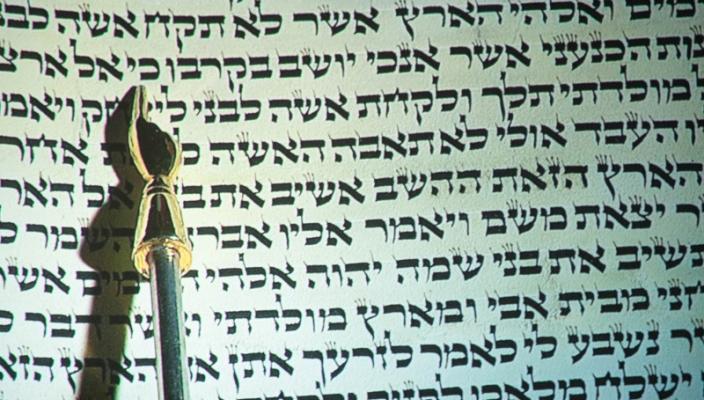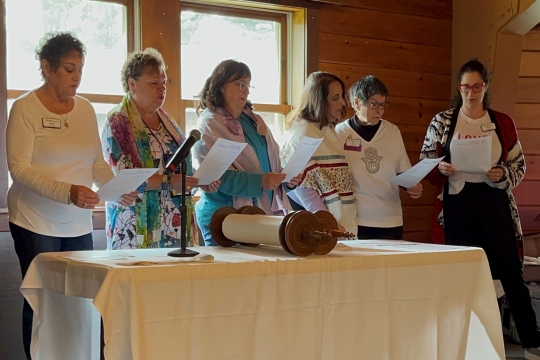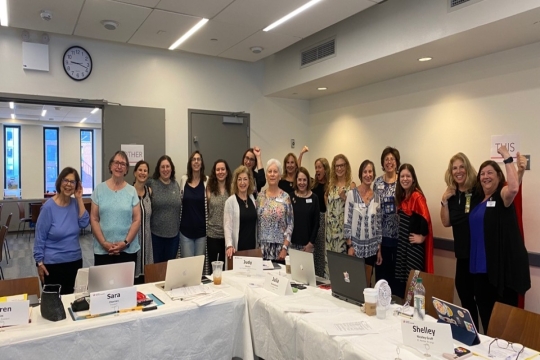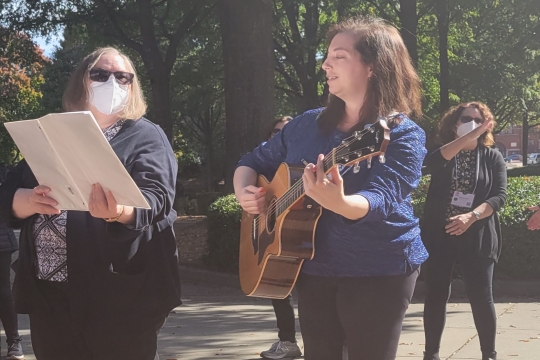
The period between Rosh Hashanah and Yom Kippur offers us the opportunity to confront the annual questions of how this New Year will be different from the one just ended. Let’s take a moment to think about a few easy ways to incorporate Torah values into our daily life.
Vayeilech, the shortest parashah, finishes the arc of Moses retelling the Torah to the children of Israel as they prepare to enter the Promised Land.
This parashah contains the final positive mitzvah, commandment of the Torah, that every individual is obligated to write a scroll for himself [Deut 31:19]. According to Rabbi Gunther Plaut, G-d’s direction to “write down this poem” means the whole Torah, as according to halachah, one is not permitted to copy merely parts of the Torah. If one cannot do it personally, they may have one written in their name. But, as humans, we don’t have to be perfect. And we don’t have to “do it all.” So, what can we realistically do?
Each time the Torah is returned to the ark, we recite the words of etz chaim: “Behold, a good doctrine has been given you, My Torah: do not forsake it. It is a tree of life to those who hold it fast, and all who cling to it find happiness. Its ways are ways of pleasantness, and all its paths are peace.” If we are all commanded to write our own Torah, and we are encouraged to hold it fast, I ask myself how could we, as Jews, satisfy both of these by becoming a “living Torah?”
What do I mean by becoming a “living Torah?” What would it mean to be a walking example of the good in Torah? For starters, we might ask ourselves what do my actions say to other people? To our families, our communities, our colleagues at work, Jews and non-Jews. For example, how do we conduct ourselves when people are watching, and when no one is watching? This season of reflection and introspection is a good time to think about what it means to be a Jew. How can I connect my daily living to my Judaism?
Defining your Judaism is in itself a challenge. There are many different ways to “be” Jewish. Think about what matters to you about being Jewish. Consider the cultural aspects, spiritual aspects, interaction and feelings towards Israel, level of practice, and observance. The important thing is to feel good about however you choose to express your Judaism, to be Jewish. And the Torah, itself, gives us many different ways to accomplish that. For example, there are people who consider themselves “gastric Jews” – they define their connection to Judaism by the foods they eat at certain times. For some, study of the ancient texts, attending Shabbat services on a regular basis, or lighting Shabbat candles every week is meaningful. Others see support of Israel as intrinsic to their identity as Jews – support including purchasing Israeli products, periodic visits to Israel, or engaging in dialog around Israel-focused topics.
Imagining the Torah as a tree conjures up so many relevant connections. Trees have roots – as do we: family, traditions, rituals – all of which support us, feed us, nurture us. At the top of the tree are green-growing edges, ever-expanding, ever reaching out, exploring the space around it, awakening and blossoming with the sun’s warmth. So, too, with us, as through the study of Torah, we are constantly learning and growing, often awakening to its ideals and values through the nurturing guidance of our teachers.
One key difference between trees and Torah is that when uprooted, sometimes trees die. Not so the Torah. The poet Heinrich Heine called the Torah “the portable homeland of the Jew.” By choosing to become a “living Torah,” we carry with us the teachings and the values of our sacred text wherever we may go. Firmly rooted in our character, we can live the 10 commandments – honor our father and mother, take to heart the mitzvah not to covet. Be mindful of the widow and the orphan in our midst. Welcome the stranger.
The final imperative of the Torah, to “write down the poem” effectively commands each of us to continue to write the Torah and to study it as well. When the Divine speaks this to Moses, the direction is to teach it to the people, and “put it in their mouths.” This underscores the promise that the Divine would not abandon them, and the people would not abandon the Divine. Rather, the word of the Divine would live within the people and give them life.
What is it that we will choose to do in this New Year to become a “living Torah?” How will we incorporate Torah Lessons into our everyday life? Will we go the extra mile to be kind, to show respect to others? Will we seek out opportunities to be generous in word and deed? Are we brave enough to actually unplug on Shabbat? How will we seek peace and pursue it? Whatever you decide is right for you, is the right answer.
Now, go and write your own Torah.
Susan C. Bass is the president of Women of Reform Judaism. Susan has been affiliated with the Reform Jewish Movement institutions during every phase of her life. A member of her Temple Youth Group (TYG), she attended regional conventions and kallot across the Southeast. Then, after graduating from the University of Georgia, she joined The Temple Sisterhood in Atlanta, GA, holding many positions before serving 3 years of a 2-year term as President from 1988-1991.
Susan became active in the WRJ Southeast District in 1988 and over a 10-year period, held several executive positions on the District board, including President from 1998- 2000. In 1991, she was elected to her first term on the National Federation of Temple Sisterhoods (NFTS, now WRJ) Board of Directors and is currently President of Women of Reform Judaism.
As an officer of WRJ, Susan has served as Vice President of the Departments of Marketing & Communications, Service to Sisterhoods & Districts, and Development and Special Projects; a member of the WRJ Constitutional Revisions, Audit, and Budget Committees; and as Co-Chair of the WRJ Task Force on Districts. Since 1993, she has also served on the WRJ Speakers’ Bureau, visiting sisterhoods across North America.
Following her term as WRJ Southeast District President in 2000, Susan was elected Secretary and then Vice President of the Southeast Council of the Union for Reform Judaism (URJ). In 2001, she was elected to the North American Board of Trustees of the URJ and has served since then. Susan served on the inaugural URJ Oversight Committee (which replaced the Executive Committee) from 2011 – 2013. She was re-elected to the URJ Board of Trustees in San Diego in 2013.
An Atlanta native, she moved to Houston, TX in August 2004, where she joined Congregation Beth Israel. Active in her sisterhood there, she served as president from 2009 – 2011.
Professionally, Susan was a teacher for eight years, spent seven years planning and helping to stage the 1996 Olympic Games in Atlanta, and then worked for management consulting firms as an administrative manager.
Related Posts

Parashat Yom Rishon shel Rosh HaShanah

Cultivating a Culture of Accountability and Belonging

